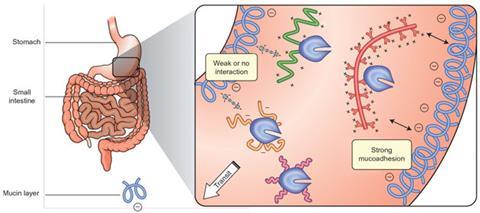Swiss researchers have discovered a way to stabilise enzymes in the digestive tract by linking polymers to the enzymes. It offers a route for developing protein-based drugs that can be administered orally without rapidly degrading, and could provide new therapeutic strategies for conditions involving abnormal enzyme activity such as coeliac disease.
Modifying enzymes with polymers for pharmaceuticals is nothing new and has been done for years to prolong their lifetime in the body and dampen any immune response. But protein-based drugs are typically injected or administered in a way that bypasses the gastrointestinal tract.

Indeed, very few studies have looked at the impact of enzyme modification on their activity following oral administration, particularly because of the inherent challenges in protecting a protein from the harsh conditions of the stomach and intestines, which evolved to degrade proteins.
Jean-Christophe Leroux and colleagues at the Swiss Federal Institute of Technology in Zurich have stepped up to this challenge, however, and shown that some polymer modifications can stabilise enzymes in different parts of the gastrointestinal tract. ‘This is an important development because there are several diseases that require, or would benefit from, the administration of enzymes by the oral route, such as pancreatic insufficiency, phenylketonuria and coeliac disease,’ says Leroux.
For several years, the team has been working in the field of coeliac disease – a genetic autoimmune disorder triggered by gluten. Using it as a starting point to study the impact of polymer conjugation on enzyme activity, they modified several enzymes that breakdown gluten with different polymers and looked at how this affected their stability.
‘We were expecting some degree of stabilisation but we were really amazed by the results obtained with the dendronised polymer [a polymer that possesses a linear main chain and brush-like side chains], which seemed to indicate some stabilisation of the glutenase in the stomach, an effect that we did not really see in vitro,’ explains Leroux.
‘This represents a real breakthrough in the field since it clearly demonstrates that the chemical linkage of enzymes to polymers allows the stabilisation of these fragile molecules,’ says Patrick Couvreur, a pharmaceuticals expert at the University of Paris-Sud, France. ‘This approach opens novel perspectives for the oral administration of therapeutic proteins.’
The researchers are still unsure exactly how the dendronised polymer stabilises the enzyme. 'There might be some unspecific interactions with the enyzme which, in combination with the mucin present in the stomach, protects the enzyme. The modified enzymes may be less prone to denaturation and less accessible for degradation by the gastric enzyme pepsin,’ suggests Leroux. ‘We are now modifying enzymes by mutation to control the insertion of the polymer on the protein scaffold. This will allow us to better understand the stabilisation mechanism,' he adds.






No comments yet